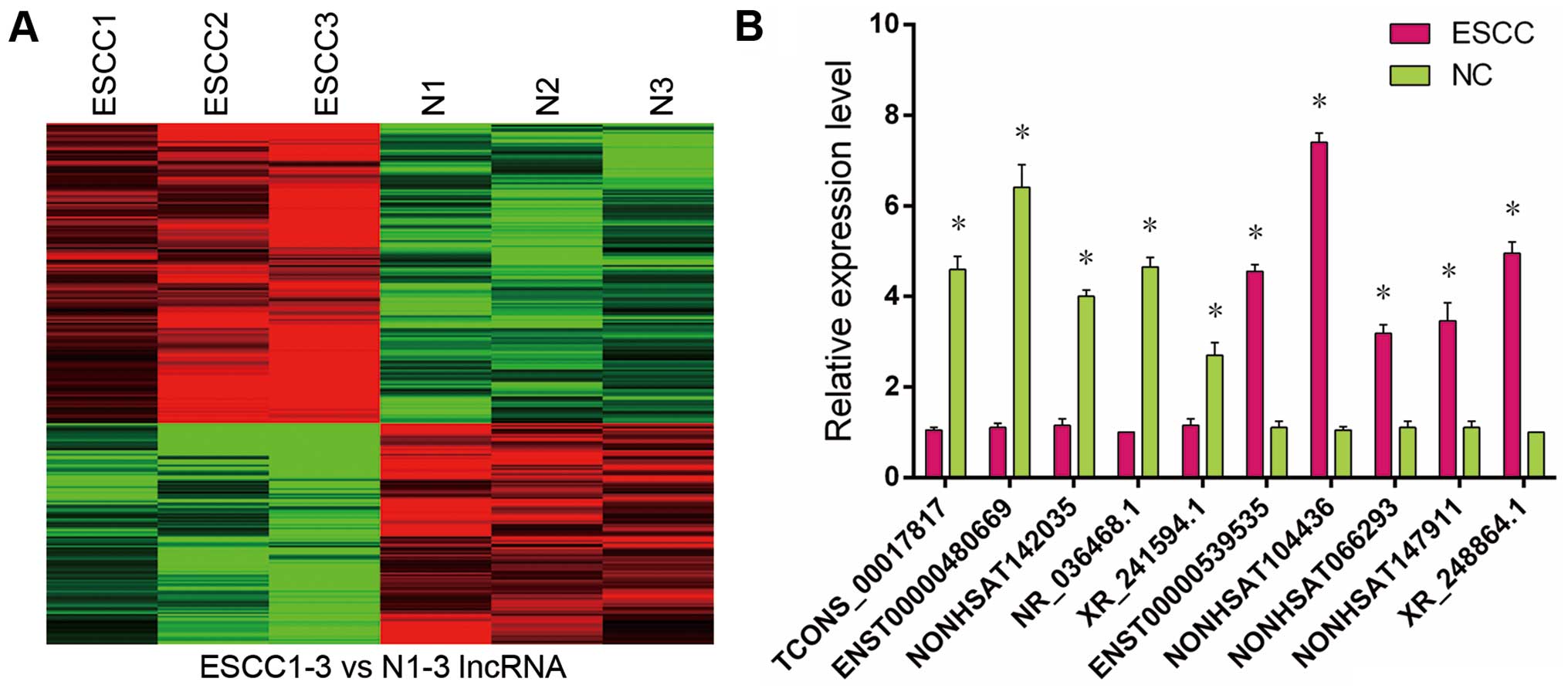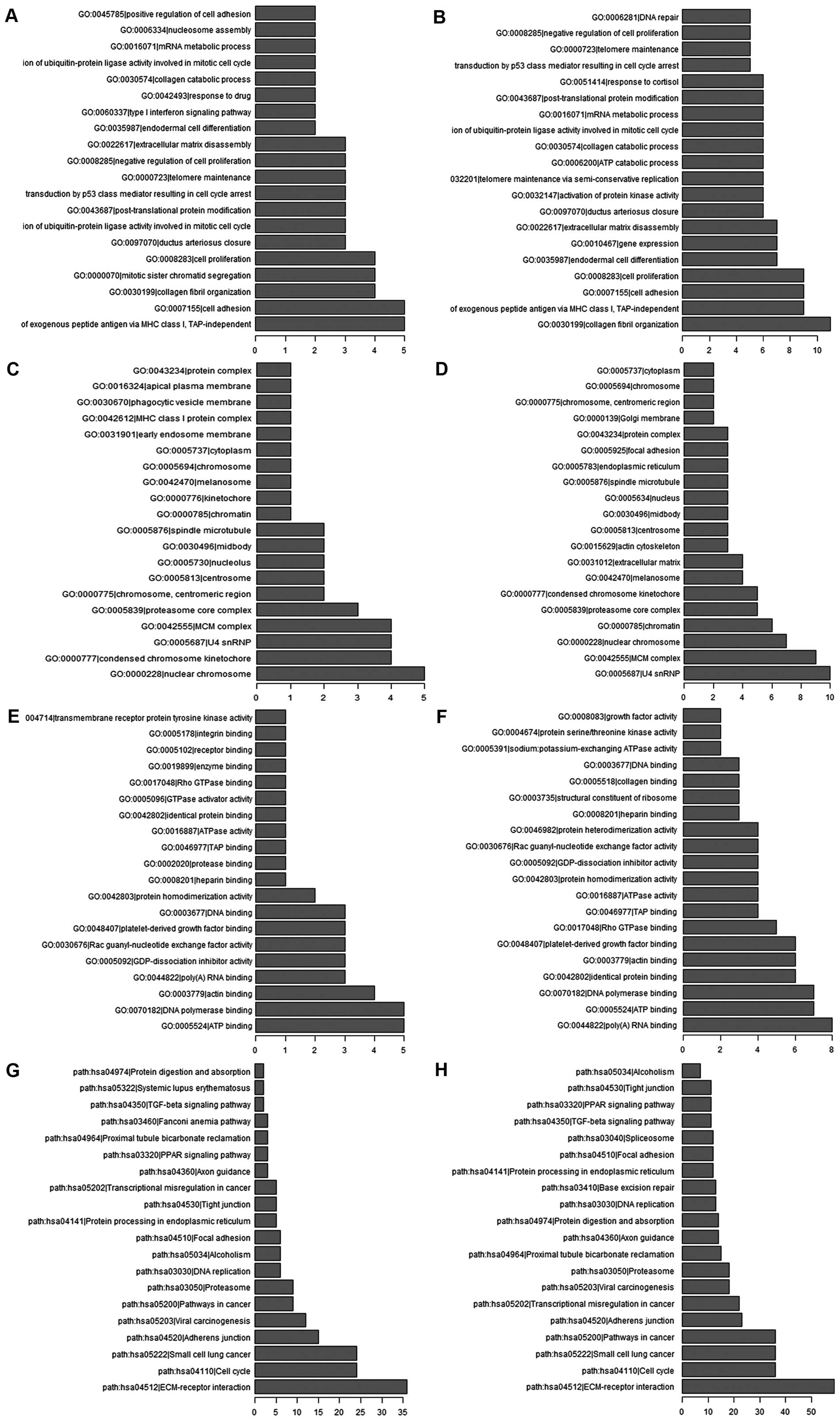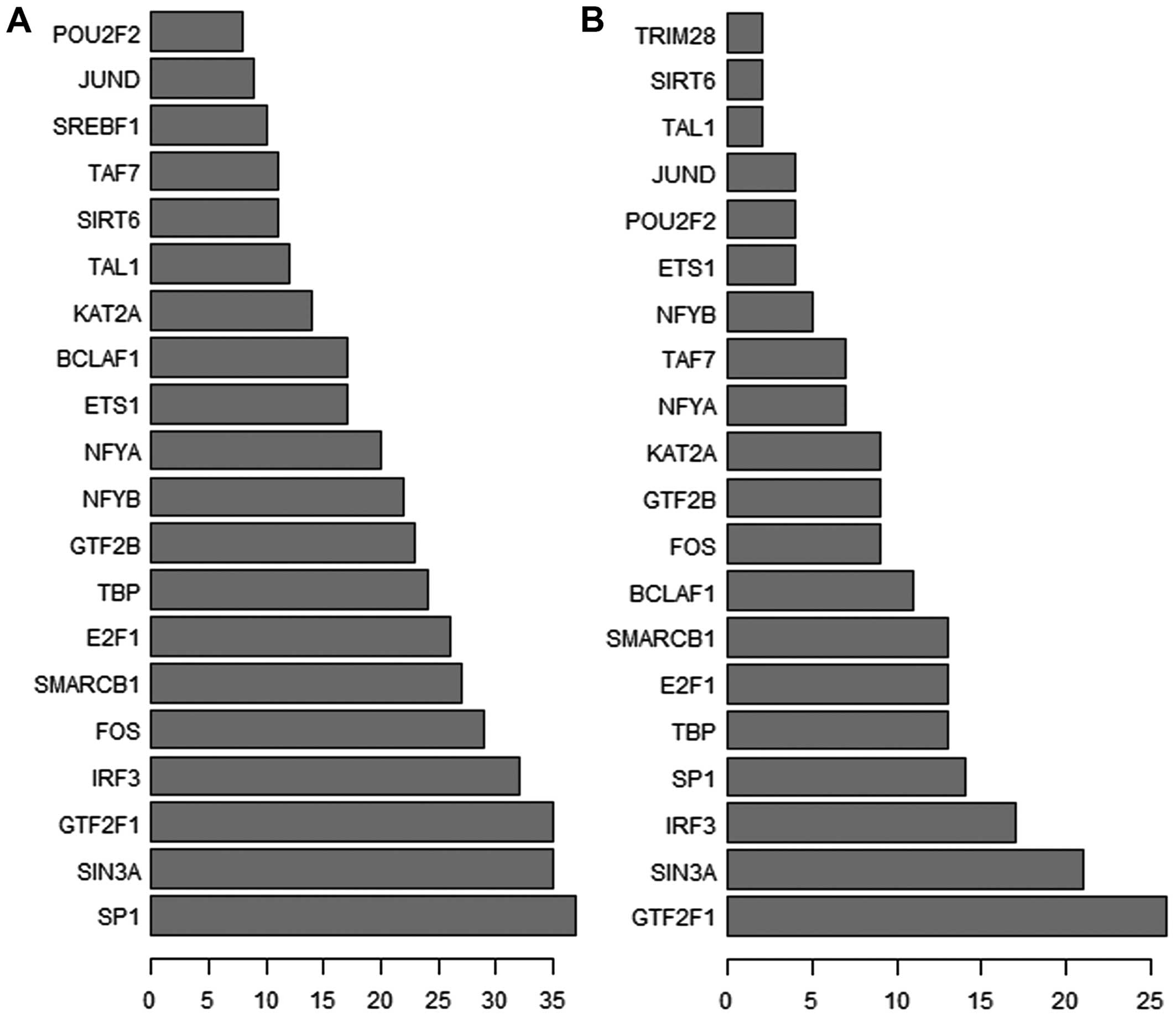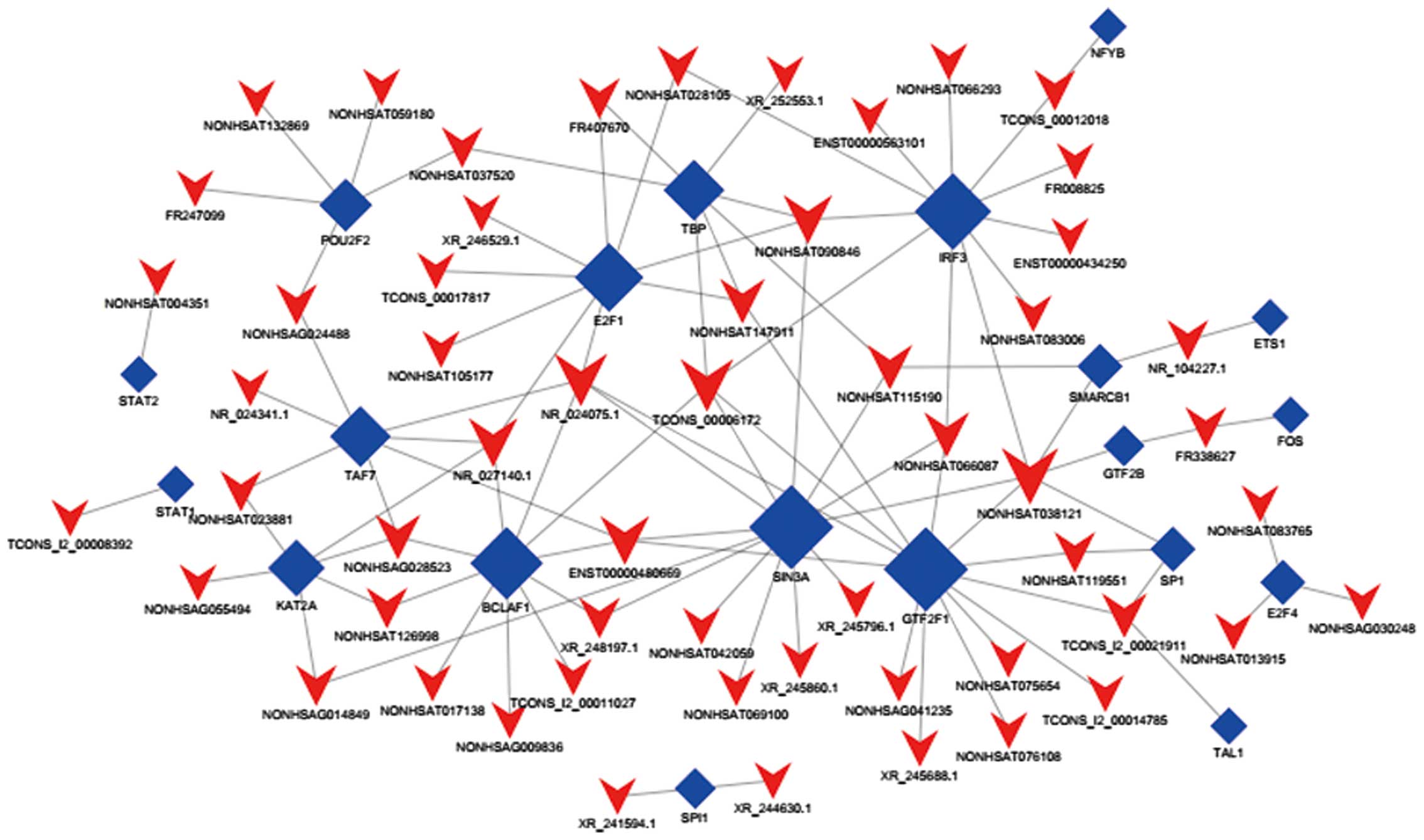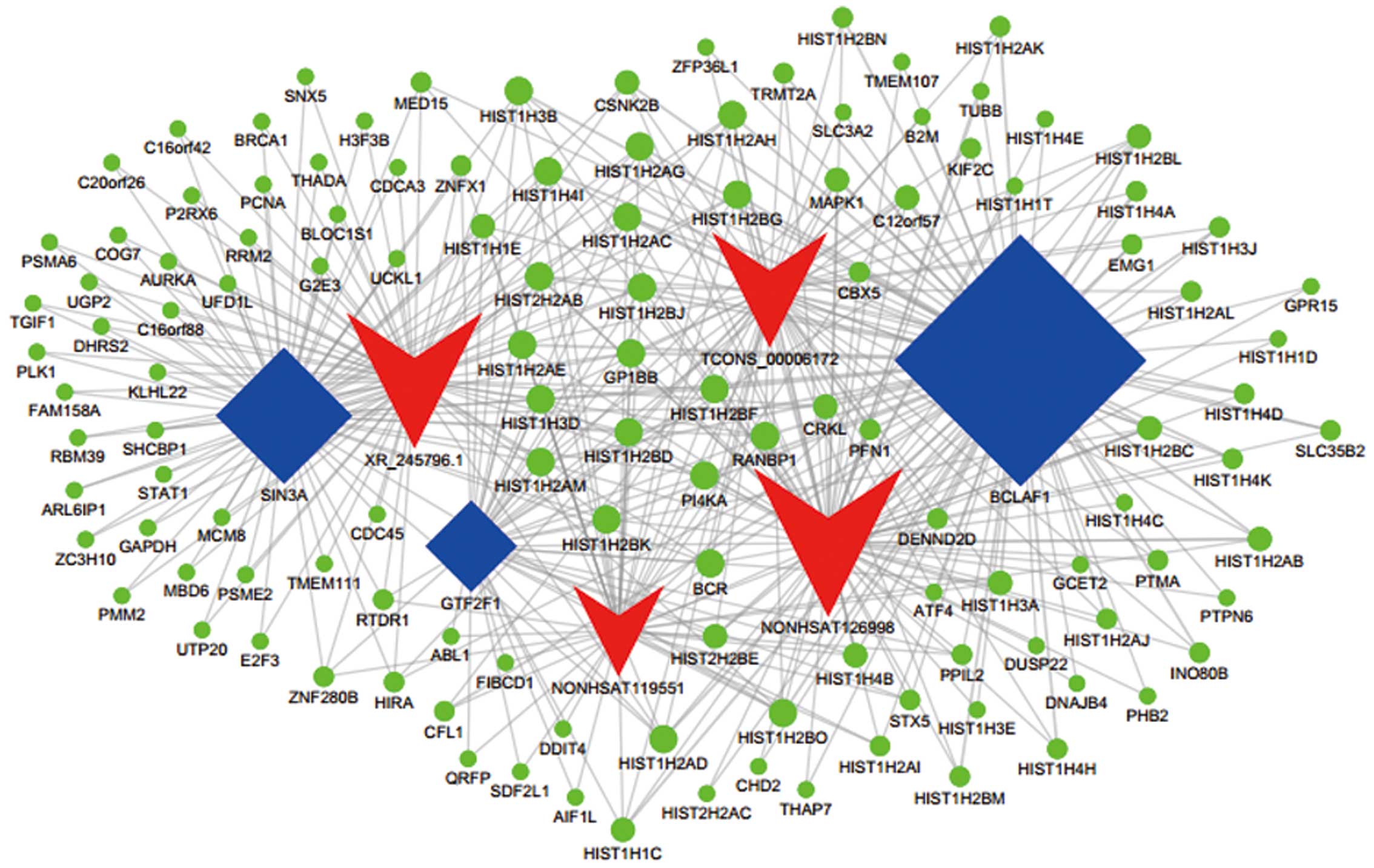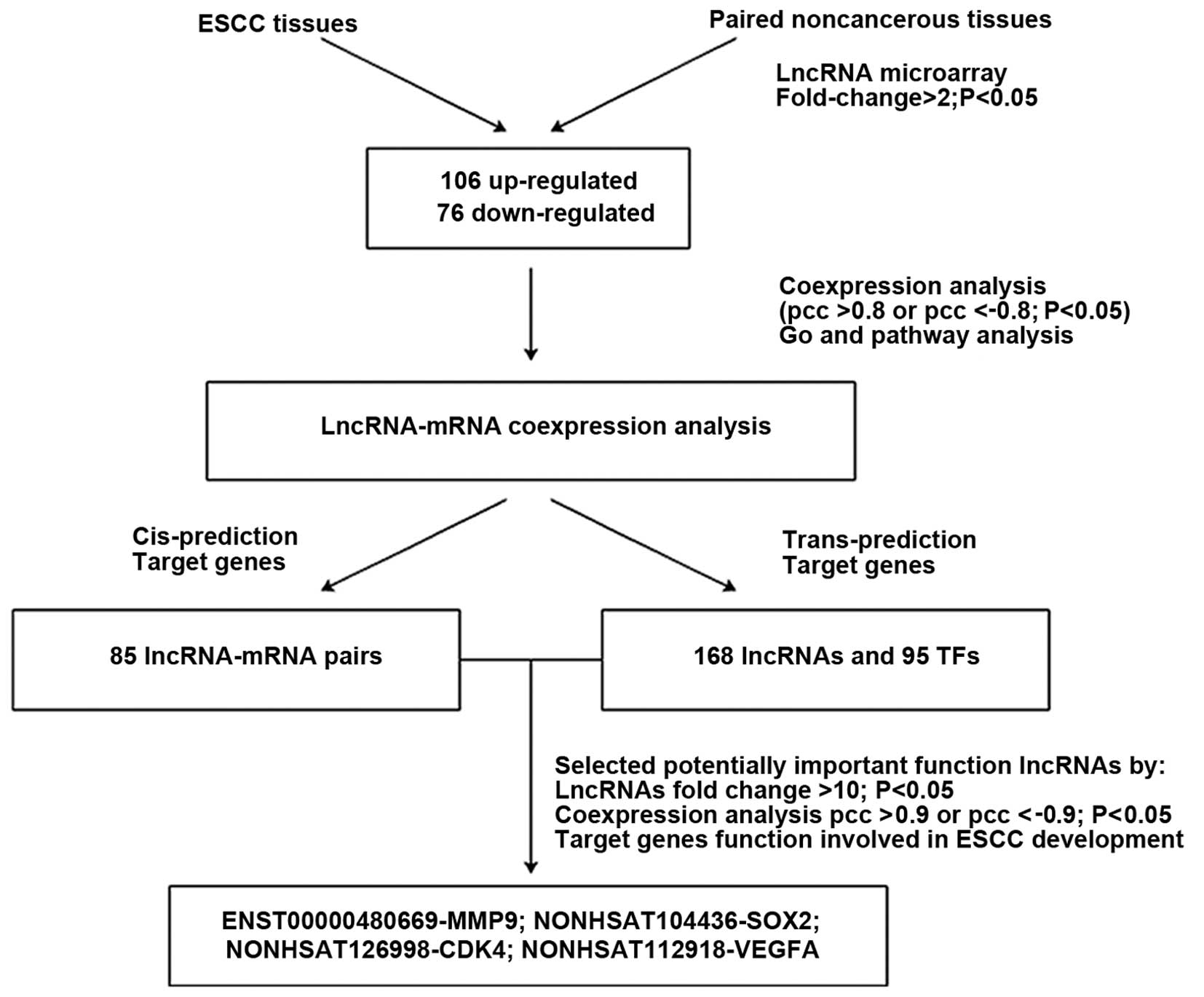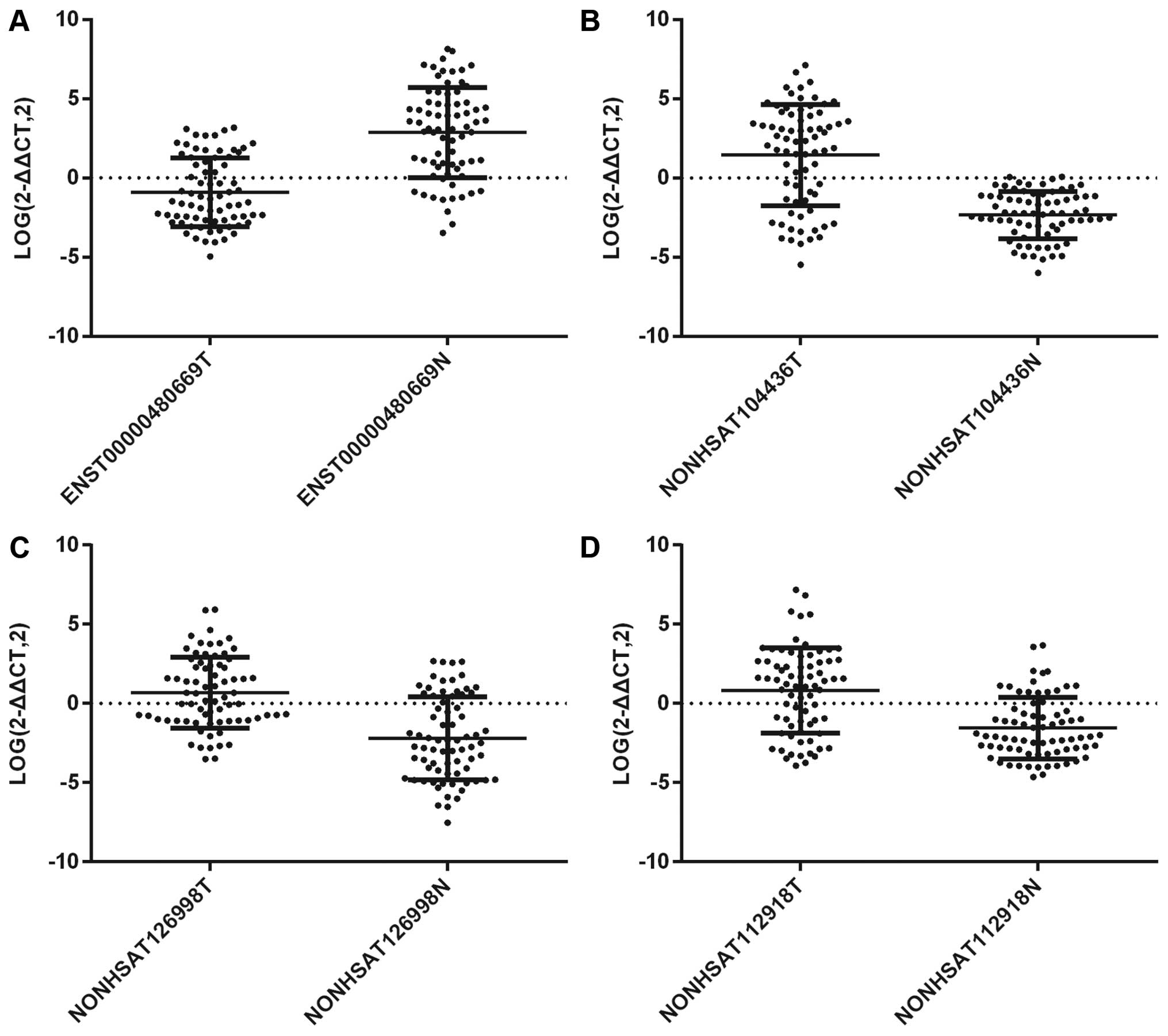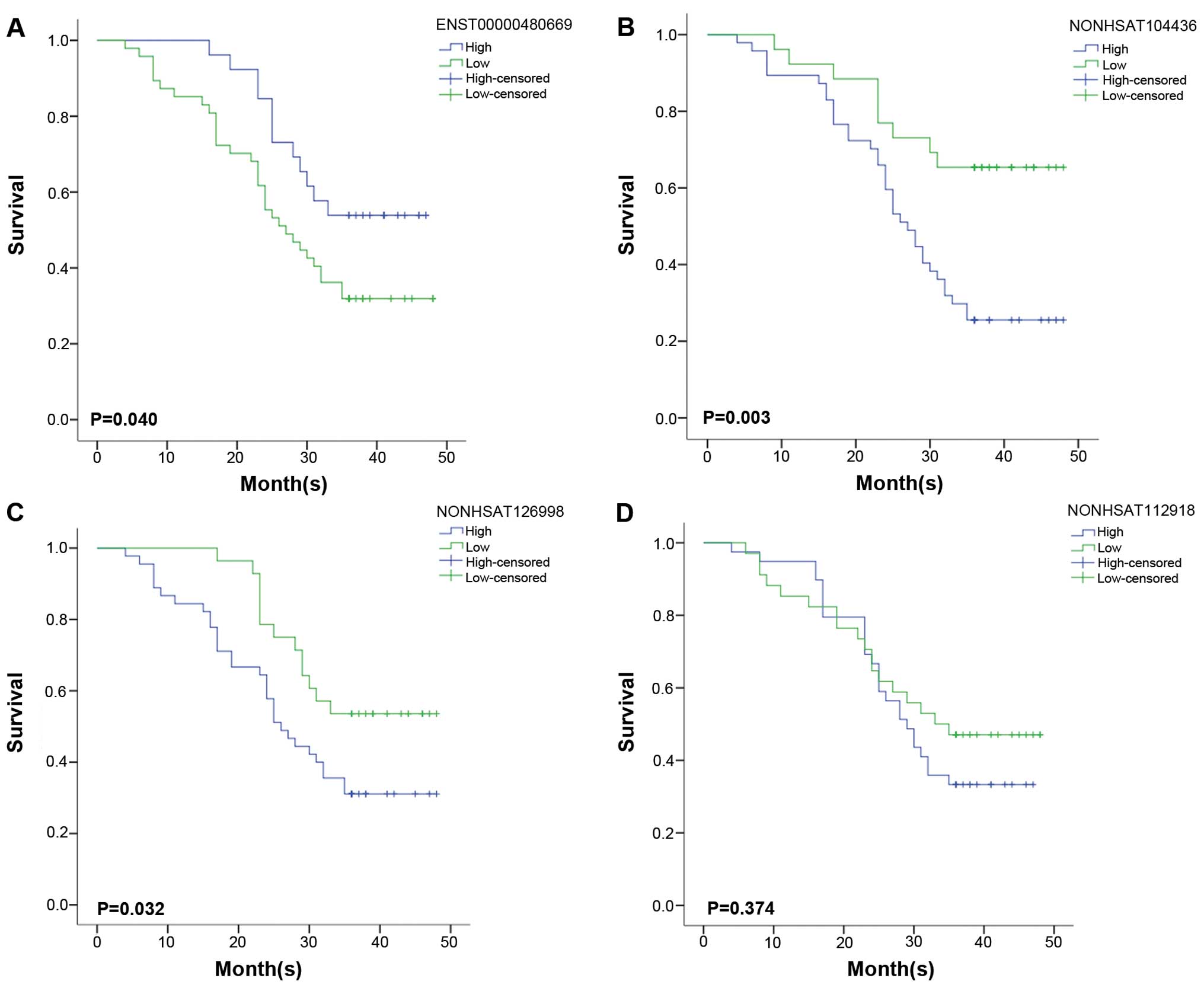Microarray expression profile analysis of aberrant long non-coding RNAs in esophageal squamous cell carcinoma
- Authors:
- Published online on: March 24, 2016 https://doi.org/10.3892/ijo.2016.3457
- Pages: 2543-2557
Abstract
Introduction
Esophageal cancer ranks as the sixth most common cancer death in the whole world (1). This disease is usually classified into EAC (esophagus adenous cancer) and ESCC (esophageal squamous cell carcinoma) based on histological types. EAC maily occurs in European and American countries, while ESCC has a high incidence of in China, accounting for >90% of esophageal cancer. Despite decline in mortality over the past ten years, the prognosis of ESCC is still very poor and the mortality of esophageal carcinoma ranks the fourth cancer death in China (2). The challenge ahead is that tiology and pathogenesis of ESCC are not yet clearly understood. The incidence varies significantly among different regions (1). Recent studies have found that genetic abnormality is one of the major causes of ESCC indicating that the occurrence of ESCC may be related to the environmental factors, as well as genetic factors (3). Therefore, to achieve early accurate diagnosis, better curative effect and prognosis assessment of ESCC, we need to understand the pathogenesis at genomic level (4).
It is known that single stranded small molecule RNA-non-encoding RNAs (microRNAs), with a length of ~21–25 nt basic group, play a negative regulatory function in post transcriptional activity. A large number of studies have described the role of microRNA in tumorigenesis, development and metastasis of cancer (5–8). Additionally, non-encoding RNAs with long chain (long non-coding RNAs, lncRNAs) are a branch of non-encoding RNA transcript with >200 nucleotides in length and account for 80% of non-encoding RNA or more (9–11). LncRNAs mainly achieve the regulation of gene expression in three levels, which are epigenetic regulation, transcriptional regulation, and post-transcriptional regulation (12,13). Considering the number, type, function and action mechanism of lncRNAs are far more abundant than miRNA, and lncRNAs may be the core of RNA world (14), increasing number of studies show that lncRNAs have a great potential to be served as biomarkers for tumorigenesis, metastasis and prognosis (15–17), and they are likely to be a new target for cancer therapy (18–20).
Therefore, we explored the potential roles of lncRNAs involved in ESCC in this study. We performed a genome wide profiling of lncRNA expression, and investigated the potential function of these distinguishable lncRNAs, and predicted lncRNAs target genes, and observed the relationship between expression level of lncRNAs and clinicopathological features, prognosis in patients with ESCC to find new bio-molecular markers.
Materials and methods
Patients and tissue samples
ESCC tissue samples and matched non-cancerous tissues ≥2 cm away from the edge of tumor tissues used in this research were from 76 ESCC patients who underwent surgical operation from March 2012 to October 2012 in Department of Thoracic Surgery, Taizhou People's Hospital Affiliated to Nantong and Jiangsu University. All patients signed written consent before esophagus resection. All specimens were stored at −80°C within 10 min of the resection. ESCC was confirmed by pathology, and clinical data including age, sex, tumor size, T stage, N stage, M stage and TNM stage were available for all the cases selected. We extracted 3 tissues for microarray assay, while the other 73 tissues were examined by qRT-PCR for clinicopathologic analysis. The study was conducted in compliance with Institutional Ethics Committee of Taizhou People's Hospital Affiliated to Nantong and Jiangsu University and the Helsinki Declaration.
RNA extraction
RNA was extracted from 76 pairs of frozen ESCC tissues and matched adjacent non-cancerous tissues by TRIzol reagent kit (Invitrogen, CA, USA). The primary procedures were according to the manufacturer's protocol. The total RNA was subpackaged separately and preserved at −80°C. The concentration and purity of RNA was detected by UV spectrophotometer according to the absorbance values at 260 and 280 nm of wavelength.
Microarray analysis
Agilent Human lncRNA Micro-array V2.0 (4*180K; Design ID, 062918; containing 46,506 lncRNAs) was used to analyze the lncRNA expression profiling of tumor tissues from ESCC patients. The lncRNA probes on gene chips were based on the well-known lncRNAs from Agilent_ncRNA, lncRNAdb, GencodeV13, H-invDB, NONCODEV3, RefSeq, ultra-conserved region encoding lncRNAs (UCR), UCSC_lincRNAs Transcripts and Ensembl. Three ESCC tissues and three matched non-cancerous tissues were analyzed by microarray as follows: i) 200-ng of total RNA from each specimen was applied to generate synthetic double stranded cDNA by Quick Amp Labeling kit, One-Color (Agilent p/n 5190-2305); ii) subsequently, the double stranded cDNA as a template was transcribed into cRNA by RNeasy Mini kit (Qiagen p/n 74104) and labeled with Cy3-dCTP; iii) labeled cRNAs were hybridized to the gene microarray; iv) the microarrays were washed and scanned by an Agilent G2505C Microarray Scanner; v) the raw data were analyzed from array images by Feature Extraction software (version10.7.1.1, Agilent Technologies). The standardized data analyses and subsequent data processing were done by Genespring (version 12.5, Agilent). The microarray hybridization was performed by Outdo Biotech, Shanghai, China.
Quantitative real-time polymerase chain reaction
In accordance to the manufacturer's protocol (Takara, Dalian, China), 2 μg of the above total RNA extracted from ESCC tissues and matched non-cancerous tissues was reverse transcribed to cDNA, respectively. Additionally, then the real-time PCR reactions were executed by SYBR PrimeScript (Takara) and the ABI7900 (Applied Biosystems, CA, USA) as follows: i) initial denaturation for 30 sec at 95°C; ii) 40 cycles for 5 sec at 95°C and for 30 sec at 59°C. Each sample was executed in triplicate. GAPDH was used as reference. The expression levels of lncRNAs were calculated by the 2−ΔΔCT method. The primer sequences are summarized in Table I.
LncRNA co-expression analysis
For each significant differentially expressed lncRNA, we calculate the Pearson correlation coefficients (PCCs) of its expression value with expression value of each mRNA. The absolute PCCs value >0.8 was considered meaningful. The PCCs value ≤0.8 indicated negative correlation, and the value >0.8 indicated positive correlation. The P-value <0.05 was considered significant. DAVID (http://david.abcc.ncifcrf.gov/gene2gene.jsp) functional annotation database was used to analyze these correlative genes.
GO and KEGG analysis
The interrelated coding genes were reassigned to functional groups by Gene Ontology (GO: http://www.geneontology.org) and Kyoto Encyclopedia of Genes and Genomes (KEGG: http://www.genome.jp/kegg) analysis. A brief overview of the process was as follows: firstly, we computed coexpressed mRNAs with each differentially expressed lncRNA, and then made up functional enrichment analysis for the set of coexpressed mRNAs. The enriched functional terms were used to predict functional term of appointed lncRNA. Ultimately, we applied hypergeometric cumulative distribution function to compute the enrichment of functional term in annotation of coexpressed mRNAs. The functional enrichment prediction of lncRNAs was based on biological processes, molecular function, cellular component and specific pathways.
Cis analysis
lncRNAs regulate the target gene expression by cis or trans mechanism. For analysis of the cis regulatory roles, the co-expressed lncRNAs-mRNAs were transcribed from the same local chromatin. Therefore, cis analysis could be an effective way to predict the target genes of lncRNAs. The potential cis-regulated mRNAs of lncRNAs had to meet the two following conditions: i) the mRNAs loci to be within 300 kbp windows of the given lncRNA; ii) the PCCs of lncRNAs-mRNAs coexpression were statistically significant (PCCs >0.8 or PCCs ≤0.8; and P<0.05). The cis-regulation regions were identified according to their location distributions by UCSC Genome Browser.
Trans analysis
Target genes of lncRNAs also can be determined by trans mechanism. Firstly, we worked out each differentially expressed IncRNA co-expressing coding genes and transcription factor in ENCODE (Encyclopedia of DNA Elements) (21), then we calculated the significance of differential genes enrichment in each TF term via hypergeometric distribution test method. A P-value enriched with significance will be returned after calculation: a small P-value indicated that differential genes incur enrichment in that TF item. Next, we counted the intersection of co-expressing coding gene sets of lncRNAs and target gene sets of transcription factor/ chromatin-regulated compounds, assessing the enrichment degree of the intersection by hypergeometric distribution, and obtaining the transcription factor obviously correlated to the IncRNAs to detect the transcription factors/chromatin-regulated factors probably jointly exerting regulating effect with IncRNAs. Finally, visible network diagrams based on the analysis result of hypergeometric distribution were drawn.
Statistical analysis
The paired sample t-test was used to compare the expression level of lncRNAs. PCCs were calculated to evaluate the correlations between the expression level of lncRNAs and mRNAs. A 2-tailed Student's t-test was applied to compare the data on clinicopathological characteristics. The survival with log-rank score to examine the statistical significance was assessed using Kaplan-Meier analysis. The relative risk was evaluated using the multivariate Cox regression model, and hazard ratios with 95% confidence intervals were quantified to calculate the results. All statistical tests were analyzed with SPSS 17.0 System (SPSS, Chicago, IL, USA). P-value <0.05 was considered having statistical significance.
Results
lncRNA expression profile of ESCC
By comparing the lncRNA expression profiles in ESCC tissues and paired non-cancerous tissues, we acquired hundreds of differentially expressed lncRNAs from 3 patients with ESCC. The criteria of significant differential lncRNAs expression were defined as the absolute fold change (FC) value >2.0 and the P-value <0.05. By the criteria mentioned above, the microarray results displayed that 182 lncRNAs, 106 upregulated and 76 downregulated, were significantly changed in ESCC tissues compared with paired non-cancerous tissues. The most upregulated lncRNAs were NONHSAT104436, ENST00000539535, ENST00000589379, NONHSAT023881 and ENST00000598376, of which NONHSAT104436 showed the largest upregulation (absolute FC, 27.25). The most downregulated lncRNAs were ENST00000530190, NONHSAT047224, ENST00000480669, NONHSAT142201 and NONHSAT083762, of which ENST00000530190 showed the largest downregulation (absolute FC, 17.88). The top 20 up- and downregulated lncRNAs are listed in Table II. The hierarchical clustering of the different expression lncRNAs among specimens were demonstrated in the heat map (Fig. 1A). By experimental experience, accurate and effective results of PCR verification were more likely obtained for lncRNAs with absolute value of FC >8. Therefore, we chose 10 significant differentially expressed lncRNAs randomly from microarray results (absolute FC >8) to validate using qRT-PCR (Fig. 1B). These data suggest that a range of lncRNA expression abnormalities in ESCC could be involved in the occurrence of ESCC.
LncRNA-mRNA coexpression profiles and the lncRNA function annotation
In order to investigate the function of lncRNAs with significant differential expression in ESCC, we mapped the lncRNA-mRNA coexpression pattern by calculating the PCCs of each lncRNA and mRNA expression value. Each lncRNA was found to be correlated with a set of mRNAs. As the file was too large, we selected NONHSAT104436 from the 182 significantly differentially expressed lncRNAs as a representative to explore the function of lncRNAs. NONHSAT104436 showed the highest upregulated lncRNAs (absolute FC, 27.25) among ESCC tissues versus paired non-carcinoma tissues. As the standard of absolute PCCs value >0.8, a total of 1,969 genes (e.g., SOX2) were related to lncRNA NONHSAT104436. The top 20 genes are listed in Table III. Further, GO and KEGG pathways were applied to annotate the lncRNA NONHSAT104436 co-expressed mRNA function. Altogether 370 enrichment GO terms were acquired. By the ranks of enrichment, the top 20 reliably predicted terms from GO analysis are listed in Table IV. It indicates that the significantly enriched GO terms were involved in structural constituent of ribosome, protein binding, angiotensin maturation, regulation of cellular amino acid metabolic process and cytosolic large ribosomal subunit. Moreover, the KEGG pathways analysis results are listed in Table V, including ribosome, proteasome, glyoxylate and dicarboxylate metabolism, RNA degradation and arginine and proline metabolism.
Then, the whole set of significantly differentially expressed lncRNA co-expression mRNAs were also annotated by applying GO and KEGG pathway analysis. Based on enrichment ranks, the top 200 and 500 reliably predicted terms from GO and KEGG pathway analysis were selected, respectively (Fig. 2). In our survey (Fig. 2A and B), the GO analysis showed that the enrichment terms in biological process mainly included TAP-independent, cell differentiation, collagen fibril organization, cell proliferation and cell adhesion. With respect to cellular components (Fig. 2C and D), the significant enrichment terms connect with differentially expressed lncRNAs mainly included nuclear chromosome, condensed chromosome kinetochore, U4 snRNP, MCM complex and proteasome core complex. Finally, ATP binding, DNA polymerase binding, actin binding, poly(A)RNA binding and platelet-derived growth factor binding were involved in the significant enriched molecular function (Fig. 2E and F). Likewise, the KEGG pathway analysis showed that the top five enrichment terms (Fig. 2G and H) were ECM-receptor interaction, cell cycle, small cell lung cancer, viral carcinogenesis, pathway in cancer.
Analysis of cis regulatory mRNAs of the aberrant lncRNAs
In order to predict the potential ‘cis-regulated mRNAs’ of lncRNAs, we identified the same locus co-expressed genes within 300 kbp windows of the significantly differentially expressed lncRNAs. Based on the absolute PCCs value >0.8 and P-value <0.05, the results of the cis prediction analysis are listed in Table VI. It included 50 significantly differently expressed lncRNAs and 67 different mRNAs. Because some genes had two or even more transcripts, the 50 lncRNAs had 85 cis genes (Table VI). Among these, lncRNA TCONS_00012018 had 5 cis genes, and two lncRNAs (NONHSAT119511 and TCONS_00017817) had 3 cis genes. VEGFA and WISP1 were the cis genes of the aberrantly expressed lncRNAs NONHSAT112918 and NR_037944.1, respectively.
Analysis of trans regulatory mRNAs of the aberrant lncRNAs
Transcription factors could mediate chromatin regulation and transcription, which interact with many lncRNAs. Therefore, trans regulatory mechanism could be another useful indicator to predict lncRNA-target genes. In this study, differentially expressed IncRNAs co-expressed coding genes enrichment in TFs terms demonstrated that a total of 168 lncRNAs were regulated by 95 TFs. Next, we selected the top 200 and top 500 according to predicted reliability rank in previously mentioned relation of ‘IncRNA-TF’, recording the frequency of each TF and summarizing those TFs with a great number of functional annotations to reflect the overall function distribution of the differentially expressed IncRNAs (Fig. 3). As demonstrated in Fig. 3, these lncRNAs may be mostly regulated by the 20 TFs. As each lncRNA could secure one to many TF-lncRNA relation groups, the network of TF-lncRNA is too large. Therefore, we took the top 100 regulating relations based on P-value to draw binary-relation network diagrams using Cytoscape software (Fig. 4). In Fig. 4, 56 lncRNAs and 20 TFs were involved, and the transcription factors GTF2F1, SIN3A and IRF3 were the most invloved, which modulate 13, 13, and 11 lncRNAs, respectively. Considering IncRNA-TF was derived from the enrichment of various genes, we drew ternary-relation network diagrams on account of the top 300 IncRNA-genes and TF-genes relation groups to reflect the relationship of TFs, lncRNAs and target genes (Fig. 5). It includes 3 upregulated lncRNAs (NONHSAT126998, TCONS_00006172 and XR_245796.1) and 1 downregulated lncRNA (XR_245796.1), 3 TFs (BCLAF1, GTF2F1 and SIN3A) and 124 target genes in this map.
Target gene predictions
The regulatory roles of lncRNA on target genes were mediated by cis- and trans-regulatory mechanisms (22,23). In this study, the cis analysis indicated 50 lncRNAs regulated 85 mRNAs (Table VI). Among these target genes, biological function of VEGFA and WISP1 have been reported in ESCC, and their paired lncRNAs were NONHSAT112918 and NR_037944.1, respectively. Considering the trans-regulatory mechanisms, differentially expressed IncRNAs co-expressed mRNA enrichment in TFs terms indicated that lncRNAs may be mostly regulated by the 20 TFs (Fig. 3). It has been reported in the literature that these TFs SP1, E2F1 and BCLAF1 were related with ESCC development (24–26). Analyzing the relationship between lncRNAs and TFs, we found that the three TFs closely related to 22 lncRNAs, and which indicated that they may have important function in ESCC. To further explore potential biological roles of lncRNAs in ESCC, we selected lncRNAs based on FC value >10 and lncRNA-mRNA co-expression analysis PCCs >0.90. The co-expressed coding genes should accord with GO and KEGG terms enrichment such as cell differentiation, ECM-receptor interaction, cell proliferation, pathway in cancer. Their target genes biological functions had been reported in ESCC in numerous cases. Ultimately, we selected four lncRNAs ENST00000480669, NONHSAT104436, NONHSAT126998 and NONHSAT112918, and the target genes were MMP9, SOX2, CDK4, and VEGFA, respectively. The screening process was as showed in Fig. 6.
Association analysis of lncRNAs with clinicopathological characteristics
To better understand the roles of lncRNAs in ESCC, we first checked the expression levels of the 4 lncRNAs (ENST00000480669, NONHSAT104436, NONHSAT126998 and NONHSAT112918). The expression of lncRNAs were quantified via RT-PCR converting the 2−ΔΔCt to log (2−ΔΔCt) values in ESCC tissues and matched non-cancerous tissues (Fig. 7). The data demonstrated that the expression pattern of the four selected lncRNAs analyzed by microarray was consistent with that done by RT-PCR. We next compared the expression levels of these genes with some specific clinicopathological characteristics. The results are listed in Tables VII and VIII. ENST00000480669 was significantly related to lymph node metastasis (P=0.026). NONHSAT104436 was significantly related to distant metastasis (P=0.008). NONHSAT126998 was significantly related to lymph node metastasis (P=0.010) and TNM stage (P=0.019). In addition, NONHSAT112918 was significantly related to tumor infiltrating stage (P=0.034).
Table VIIThe relationship between clinical features and the expression level of lncRNA ENST00000480669 and NONHSAT104436 in 73 patients with ESCC. |
Table VIIIThe relationship between clinical features and the expression level of lncRNA NONHSAT126998 and NONHSAT112918 in 73 patients with ESCC. |
Correlations between lncRNA expression and ESCC prognosis
Univariate survival analysis was used to evaluate the relationship between the lncRNA expression level and cancer prognosis. There were no samples excluded from the univariate survival analysis during the three years of follow-up. The 3-year overall survival rate of 73 patients was 39.7%. The outcome of statistical analysis showed that the cumulative overall survival rate was poor with high expression of NONHSAT104436 and NONHSAT126998. The 3-year survival rate for ESCC patients with high expression of NONHSAT104436 was 25.5%, whereas, the patients with NONHSAT104436 low expression had a 3-year survival rate of 65.4% (P=0.003, Fig. 8). The results of NONHSAT126998 were similar to that of NONHSAT104436. The patients with high expression of NONHSAT126998 had a poorer 3-year survival rate (31.1.0%) than the patients with low expression of NONHSAT126998 (53.6%; P=0.032, Fig. 8). On the contrary, the findings of ENST00000480669 were different from NONHSAT104436 and NONHSAT126998, i.e., patients with high expression of ENST00000480669 gained a relatively higher 3-year survival rate (53.8%) than patients with low expression of ENST00000480669 (31.9%; P=0.040, Fig. 8). There was no statistical significance for the overall survival rate between high expression and low expression of NONHSAT112918 (P=0.374). Three-year survival rate for high and low expression was 33.3 and 41.7%, respectively (Fig. 8). From the multivariate Cox regression analysis, only NONHSAT104436 was an independent prognostic factor (P=0.017; 95% CI, 1.226–8.123; Table IX).
Table IXMultivariate Cox regression analysis for ENST00000480669, NONHSAT104436, NONHSAT126998 and NONHSAT112918. |
Discussion
Recently, lncRNAs were reported to be involved in numerous biological process and be connected with various diseases, such as cancer (27–29), and many lncRNAs play critical roles in regulating gene expression (30,31). Since AFAP1-AS1 (an lncRNA transcript) was demonstrated differentially expressed in esophageal adenocarcinoma, an increasing number of aberrant expression of lncRNAs have been reported in esophageal cancer (32). However, the understanding of the genome-wide expression patterns and functions of lncRNAs in ESCC is still limited.
In this study, we examined the profiles of lncRNA expression in ESCC tissues and matched non-cancerous tissues by microarray assay and identified 182 lncRNAs with statistically significant different expression patterns. Then, we performed an integrated analysis of these lncRNAs, concentrating on lncRNA co-expressed gene analyses, gene ontology and pathway analyses, target gene prediction analyses to explore their potential function and target genes in ESCC. Finally, we selected four dysregulated lncRNAs (ENST00000480669, NONHSAT104436, NONHSAT126998 and NONHSAT112918) to validate their expression patterns in patients with ESCC by qRT-PCR. The four lncRNAs showed significant correlation to certain clinicopathological features, including lymph node metastasis, tumor infiltrating stage, distant metastasis and TNM stage. ENST00000480669, NONHSAT104436 and NONHSAT126998 were related to the prognosis of ESCC in cancer patients. Among the four aberrant lncRNAs, only NONHSAT104436 was an independent prognostic factor.
It is known that the expression of a single lncRNA could be correlated with hundreds of coding genes. Therefore, it is a big challenge to decipher the functions of lncRNAs. Compelling evidence has shown that similar expression patterns of genes potentially shared related functions or were involved in the same biological pathways (33,34). The GO concept used a common vocabulary to query and retrieve gene and gene product based on their core biological functions through a dynamic and flexible way in multiple organisms (35). Here, we constructed coexpression of coding-non-coding genes and used GO and pathway analysis to predict the lncRNA functions in ESCC. Based on our data, the main enriched biological processes in predicting differently expressed lncRNAs were closely tied up to ESCC development and progression, such as ‘extracellular matrix’, ‘immune responses’, ‘cell differentiation’, ‘cell proliferation’. In the above main enriched terms from GO analysis, the most significant GO term in biological processes was ‘extracellular matrix’, indicating that dysregulated lncRNAs could play the leading role in regulating extracellular matrix expression. While the extracellular matrix is the first barrier to hold back the metastasis of tumor, based on the significant KEGG pathways analyses, the most correlated pathways were ‘cell cycle’, ‘ECM-receptor interaction’, ‘pathways in cancer’, ‘TGF-β signaling pathway’ and ‘transcriptional misregulation in cancer’, which also proved that the aberrant lncRNAs may play an crucial role in ESCC development and progression. In these lncRNAs, NONHSAT104436 drew our attention, as it was the most upregulated in the 182 significantly differently expressed lncRNAs, and it was significantly associated with SOX2 (PCC, −0.99), whose function has been confirmed in ESCC and was consistent with GO and pathway analysis.
Because of the diverse and complex functions of the lncRNAs, the molecular regulatory mechanisms of lncRNAs remain unknown. The function of lncRNAs has been reported to regulate their own transcriptions or their neighboring coding genes by cis-regulatory mechanisms (36,37), which was regarded as an lncRNA intrinsic capacity (38). The cis-regulatory mechanism was reported to be used as one of the methods to predict the lncRNA target genes (23). In this study, there are 50 significantly different expressed lncRNAs that regulate 85 mRNAs by cis regulatory mechanisms. With regard to their expression changes, 74 pairs demonstrated positive correlation, and 11 pairs have negative correlation. Among these genes, VEGFA was the cis gene of lncRNA NONHSAT112918, and its biological function has been confirmed in ESCC by a large number of scientific studies. As the target genes were regulated by each corresponding lncRNA, expression change of lncRNAs in ESCC tissue may influence the expression of the target genes, and these lncRNAs may affect ESCC development and progression. Through analyzing the cis, we may gain the target genes of lncRNAs and more information about their regulatory mechanisms in ESCC.
However, the lncRNA co-expressed encoding genes mostly lie in different regions of the same chromosome, or even in different chromosomes. So it is not enough to predict the target gene of lncRNAs by using the cis regulation mechanism only. The trans regulation mechanism of lncRNAs can regulate the expression of target genes on a different locus. It was reported that many lncRNAs interact with transcription factors, and increasing evidence proves the trans mechanism in lncRNAs. Jiang et al and Yang et al developed web-based tools to provide integrated views for common transcription factors and lncRNA genes based on ChIP-Seq data (39,40). Lopez-Pajares et al constructed an lncRNA-TF network for epidermal differentiation (41). Based on trans-regulatory mechanism, this study demonstrated 168 lncRNAs were regulated by 95 TFs. Through cluster analysis, we found most of the aberrant IncRNAs co-expressed mRNAs enriched in 20 TFs, which may play an important role in regulating lncRNA expression in ESCC. Three TFs E2F1, BCLAF1 and SP1 of the above 20 TFs have been reported in ESCC (24–26). The biological meaning of the elevated expression of TFs GTF2F1, SIN3A and IRF3 in ESCC remain to be validated. We explored the relationship of lncRNA-TFs and lncRNA-TFs-target genes. The results showed lncRNAs ENST00000480669 and NONHSAT126998 were significantly associated with E2F1 and BCLAF1, which indicated that they may have important function in ESCC.
Aberrant lncRNAs have been reported to be involved in tumorigenesis, invasion and metastasis (15–17). Investigating differential expression of lncRNAs in various tumor tissues may provide new understanding for cancer diagnosis, prognosis and targeted therapy. For instance, the lncRNA HOTAIR expression was elevated in primary and metastasizing breast tumors, and the expression level of HOTAIR in primary tumors was a strong predictor of final metastasis and prognosis (29). Li et al suggested that a three-lncRNA signature containing lncRNAs XLOC_013014, ENST00000435885.1 and ENST00000547963.1 was a novel biomarker for the prognosis of ESCC (42). High-throughput cancer genome sequencing also have identified valuable biomarkers in ESCC (4,43). In this study, we first reported four lncRNAs whose coding genes had been proved positively correlated with ESCC and the relationship among those four lncRNAs and clinical clinicopathological features, prognosis were analyzed in 73 patients with ESCC. We discovered all the four were significantly related with one or more clinicopathological features. More importantly, the ESCC patients with high expression of NONHSAT104436 were vulnerable to cancer metastasis. Further univariate survival analysis demonstrated that ESCC patients with low expression of ENST00000480669 had a markedly decreased survival rate in a 3-year survey. In addition, ESCC patients with low expression of NONHSAT126998 or NONHSAT104436 had a better prognosis. These results indicate that ENST00000480669, NONHSAT104436 and NONHSAT126998 were worth exploring in predicting prognosis for ESCC patients. Significantly, in the multivariate analysis, the retrospective study of 73 ESCC patients indicated that NONHSAT104436 was the only independent prognostic factor in ESCC. This result provides that NONHSAT104436 may be a promising biomarker for diagnosis and prognosis of ESCC.
Acknowledgements
This study was supported by the Health Foundation (grant no. H201260) of Jiangsu Province, China, the Social Development Foundation (Grant no. TS029) of Taizhou municipal government, China. The authors are grateful to Dr Xueliang Han, for his assistance with the manuscript preparation.
References
|
Jemal A, Bray F, Center MM, Ferlay J, Ward E and Forman D: Global cancer statistics. CA Cancer J Clin. 61:69–90. 2011. View Article : Google Scholar : PubMed/NCBI | |
|
Chen W, Zheng R, Zeng H, Zhang S and He J: Annual report on status of cancer in China, 2011. Chin J Cancer Res. 27:2–12. 2015. View Article : Google Scholar : PubMed/NCBI | |
|
Gao Y, Hu N, Han X, Giffen C, Ding T, Goldstein A and Taylor P: Family history of cancer and risk for esophageal and gastric cancer in Shanxi, China. BMC Cancer. 9:2692009. View Article : Google Scholar : PubMed/NCBI | |
|
Song Y, Li L, Ou Y, Gao Z, Li E, Li X, Zhang W, Wang J, Xu L, Zhou Y, et al: Identification of genomic alterations in oesophageal squamous cell cancer. Nature. 509:91–95. 2014. View Article : Google Scholar : PubMed/NCBI | |
|
Bartel DP: MicroRNAs: Genomics, biogenesis, mechanism, and function. Cell. 116:281–297. 2004. View Article : Google Scholar : PubMed/NCBI | |
|
Lewis BP, Burge CB and Bartel DP: Conserved seed pairing, often flanked by adenosines, indicates that thousands of human genes are microRNA targets. Cell. 120:15–20. 2005. View Article : Google Scholar : PubMed/NCBI | |
|
Png KJ, Halberg N, Yoshida M and Tavazoie SF: A microRNA regulon that mediates endothelial recruitment and metastasis by cancer cells. Nature. 481:190–194. 2011. View Article : Google Scholar : PubMed/NCBI | |
|
Isozaki Y, Hoshino I, Akutsu Y, Hanari N, Mori M, Nishimori T, Murakami K, Akanuma N, Takeshita N, Maruyama T, et al: Usefulness of microRNA-375 as a prognostic and therapeutic tool in esophageal squamous cell carcinoma. Int J Oncol. 46:1059–1066. 2015. | |
|
Spizzo R, A1meida MI, Colombatti A and Calin GA: Long non-coding RNAs and cancer: A new frontier of translational research? Oncogene. 3 l:4577–4587. 2012. View Article : Google Scholar | |
|
Necsulea A, Soumillon M, Warnefors M, Liechti A, Daish T, Zeller U, Baker JC, Grützner F and Kaessmann H: The evolution of lncRNA repertoires and expression patterns in tetrapods. Nature. 505:635–640. 2014. View Article : Google Scholar : PubMed/NCBI | |
|
Yang L, Duff MO, Graveley BR, Carmichael GG and Chen LL: Genome-wide characterization of non-polyadenylated RNAs. Genome Biol. 12:R162011. View Article : Google Scholar | |
|
Caley DP, Pink RC, Trujillano D and Carter DR: Long non-coding RNAs, chromatin, and development. Sci World J. 10:90–102. 2010. View Article : Google Scholar | |
|
Mercer TR, Dinger ME and Mattick JS: Long non-coding RNAs: Insights into functions. Nat Rev Genet. 10:155–159. 2009. View Article : Google Scholar : PubMed/NCBI | |
|
Guttman M, Amit I, Garber M, French C, Lin MF, Feldser D, Huarte M, Zuk O, Carey BW, Cassady JP, et al: Chromatin signature reveals over a thousand highly conserved large non-coding RNAs in mammals. Nature. 458:223–227. 2009. View Article : Google Scholar : PubMed/NCBI | |
|
Yuan JH, Yang F, Wang F, Ma JZ, Guo YJ, Tao QF, Liu F, Pan W, Wang TT, Zhou CC, et al: A long non-coding RNA activated by TGF-β promotes the invasion-metastasis cascade in hepatocellular carcinoma. Cancer Cell. 25:666–681. 2014. View Article : Google Scholar : PubMed/NCBI | |
|
Gupta RA, Shah N, Wang KC, Kim J, Horlings HM, Wong DJ, Tsai MC, Hung T, Argani P, Rinn JL, et al: Long non-coding RNA HOTAIR reprograms chromatin state to promote cancer metastasis. Nature. 464:1071–1076. 2010. View Article : Google Scholar : PubMed/NCBI | |
|
Qiu JJ, Lin YY, Ding JX, Feng WW, Jin HY and Hua KQ: Long non-coding RNA ANRIL predicts poor prognosis and promotes invasion/metastasis in serous ovarian cancer. Int J Oncol. 46:2497–2505. 2015.PubMed/NCBI | |
|
Yang H, Liu Z, Yuan C, Zhao Y, Wang L, Hu J, Xie D, Wang L and Chen D: Elevated JMJD1A is a novel predictor for prognosis and a potential therapeutic target for gastric cancer. Int J Clin Exp Pathol. 8:11092–11099. 2015.PubMed/NCBI | |
|
Kim K, Jutooru I, Chadalapaka G, Johnson G, Frank J, Burghardt R, Kim S and Safe S: HOTAIR is a negative prognostic factor and exhibits pro-oncogenic activity in pancreatic cancer. Oncogene. 32:1616–1625. 2013. View Article : Google Scholar | |
|
Martínez-Fernández M, Rubio C, Segovia C, López-Calderón FF, Dueñas M and Paramio JM: EZH2 in Bladder Cancer, a Promising Therapeutic Target. Int J Mol Sci. 16:27107–27132. 2015. View Article : Google Scholar : PubMed/NCBI | |
|
Gerstein MB, Kundaje A, Hariharan M, Landt SG, Yan KK, Cheng C, Mu XJ, Khurana E, Rozowsky J, Alexander R, et al: Architecture of the human regulatory network derived from ENCODE data. Nature. 489:91–100. 2012. View Article : Google Scholar : PubMed/NCBI | |
|
Guttman M and Rinn JL: Modular regulatory principles of large non-coding RNAs. Nature. 482:339–346. 2012. View Article : Google Scholar : PubMed/NCBI | |
|
Wang J, Xie H, Ling Q, et al: Coding-non-coding gene expression in intrahepatic cholangiocarcinoma. Transl Res. 168:107–121. 2016. View Article : Google Scholar | |
|
Lu XF, Li EM, Du ZP, Xie JJ, Guo ZY, Gao SY, Liao LD, Shen ZY, Xie D and Xu LY: Specificity protein 1 regulates fascin expression in esophageal squamous cell carcinoma as the result of the epidermal growth factor/extracellular signal-regulated kinase signaling pathway activation. Cell Mol Life Sci. 67:3313–3329. 2010. View Article : Google Scholar : PubMed/NCBI | |
|
Yeo SY, Ha SY, Yu EJ, Lee KW, Kim JH and Kim SH: ZNF282 (Zinc finger protein 282), a novel E2F1 co-activator, promotes esophageal squamous cell carcinoma. Oncotarget. 5:12260–12272. 2014. View Article : Google Scholar : PubMed/NCBI | |
|
Chen Y, Wang Y, Song H, Wang J, Yang H, Xia Y, Xue J, Li S, Chen M and Lu Y: Expression profile of apoptosis-related genes potentially explains early recurrence after definitive chemoradiation in esophageal squamous cell carcinoma. Tumour Biol. 35:4339–4346. 2014. View Article : Google Scholar : PubMed/NCBI | |
|
Rinn JL and Chang HY: Genome regulation by long non-coding RNAs. Annu Rev Biochem. 81:145–166. 2012. View Article : Google Scholar | |
|
Chen G, Wang Z, Wang D, Qiu C, Liu M, Chen X, Zhang Q, Yan G and Cui Q: LncRNADisease: A database for long-non-coding RNA-associated diseases. Nucleic Acids Res. 41D:D983–D986. 2013. View Article : Google Scholar | |
|
Gutschner T and Diederichs S: The hallmarks of cancer: A long non-coding RNA point of view. RNA Biol. 9:703–719. 2012. View Article : Google Scholar : PubMed/NCBI | |
|
Huarte M: LncRNAs have a say in protein translation. Cell Res. 23:449–451. 2013. View Article : Google Scholar : | |
|
Nagano T and Fraser P: No-nonsense functions for long non-coding RNAs. Cell. 145:178–181. 2011. View Article : Google Scholar : PubMed/NCBI | |
|
Hao Y, Wu W, Shi F, Dalmolin RJ, Yan M, Tian F, Chen X, Chen G and Cao W: Prediction of long non-coding RNA functions with co-expression network in esophageal squamous cell carcinoma. BMC Cancer. 15:1682015. View Article : Google Scholar | |
|
Lee HK, Hsu AK, Sajdak J, Qin J and Pavlidis P: Coexpression analysis of human genes across many microarray data sets. Genome Res. 14:1085–1094. 2004. View Article : Google Scholar : PubMed/NCBI | |
|
Eisen MB, Spellman PT, Brown PO and Botstein D: Cluster analysis and display of genome-wide expression patterns. Proc Natl Acad Sci USA. 95:14863–14868. 1998. View Article : Google Scholar : PubMed/NCBI | |
|
Ashburner M, Ball CA, Blake JA, Botstein D, Butler H, Cherry JM, Davis AP, Dolinski K, Dwight SS, Eppig JT, et al: The Gene Ontology Consortium: Gene ontology: Tool for the unification of biology. Nat Genet. 25:25–29. 2000. View Article : Google Scholar : PubMed/NCBI | |
|
Wang KC, Yang YW, Liu B, Sanyal A, Corces-Zimmerman R, Chen Y, Lajoie BR, Protacio A, Flynn RA, Gupta RA, et al: A long non-coding RNA maintains active chromatin to coordinate homeotic gene expression. Nature. 472:120–124. 2011. View Article : Google Scholar : PubMed/NCBI | |
|
Guenzl PM and Barlow DP: Macro lncRNAs: A new layer of cis-regulatory information in the mammalian genome. RNA Biol. 9:731–741. 2012. View Article : Google Scholar : PubMed/NCBI | |
|
Lee JT: Lessons from X-chromosome inactivation: Long ncRNA as guides and tethers to the epigenome. Genes Dev. 23:1831–1842. 2009. View Article : Google Scholar : PubMed/NCBI | |
|
Jiang Q, Wang J, Wang Y, Ma R, Wu X and Li Y: TF2LncRNA: Identifying common transcription factors for a list of lncRNA genes from ChIP-Seq data. BioMed Res Int. 2014:3176422014. View Article : Google Scholar : PubMed/NCBI | |
|
Yang JH, Li JH, Jiang S, Zhou H and Qu LH: ChIPBase: A database for decoding the transcriptional regulation of long non-coding RNA and microRNA genes from ChIP-Seq data. Nucleic Acids Res. 41(D1): D177–D187. 2013. View Article : Google Scholar : | |
|
Lopez-Pajares V, Qu K, Zhang J, Webster DE, Barajas BC, Siprashvili Z, Zarnegar BJ, Boxer LD, Rios EJ, Tao S, et al: A LncRNA-MAF:MAFB transcription factor network regulates epidermal differentiation. Dev Cell. 32:693–706. 2015. View Article : Google Scholar : PubMed/NCBI | |
|
Li J, Chen Z, Tian L, Zhou C, He MY, Gao Y, Wang S, Zhou F, Shi S, Feng X, et al: LncRNA profile study reveals a three-lncRNA signature associated with the survival of patients with oesophageal squamous cell carcinoma. Gut. 63:1700–1710. 2014. View Article : Google Scholar : PubMed/NCBI | |
|
Dulak AM, Stojanov P, Peng S, Lawrence MS, Fox C, Stewart C, Bandla S, Imamura Y, Schumacher SE, Shefler E, et al: Exome and whole-genome sequencing of esophageal adenocarcinoma identifies recurrent driver events and mutational complexity. Nat Genet. 45:478–486. 2013. View Article : Google Scholar : PubMed/NCBI |



